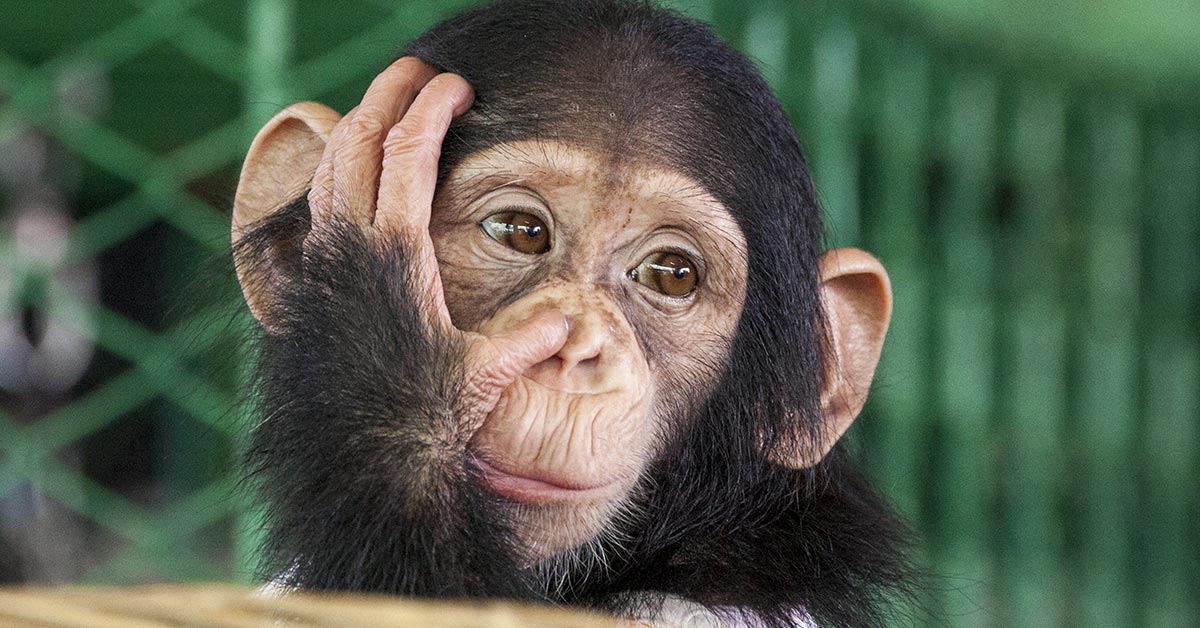Scientists put human genes into monkeys and were able to make their brains grow.
Chimps are our closest living relatives, but our brains are about three times the size of theirs [1]. Presumably, it is our larger human brains that make us the dominant species over our primate cousins. But is size all that matters? If we make a monkey’s brain larger, will that make the monkey smarter, too?
The Evolution of the Human Brain
At one point, our brains were likely around the size of a current chimpanzee brain. Over the course of human history, however, the brains of our ancestors tripled in size. Today, we have the largest and most complex brains of any living primate.
For the first several million years of human evolution, the brain size of our ancestors only increased in small increments. This allowed them to do simple tasks like make primitive tools. Around eight hundred thousand years ago, however, the human brain suddenly began evolving rapidly. It continued to do so for the next six hundred thousand years.
Most scientists believe that this was due to dramatic climate change during that time. As humans dealt with an increasingly unpredictable environment, their larger and larger brains helped them to adapt.
Aside from size, one of the main differences between our brains and chimpanzee brains lies in the temporal cortex. We have significantly more white matter in this region of the brain. This means that we have more connections between nerve cells, and a greater ability to process information [2].
The Human Neocortex
One of the biggest changes to our brains that occurred during that time was the evolution of our neocortex. Human brains were growing so quickly that our craniums (aka- skulls) couldn’t keep up. The brain started to become cramped, so the neocortex began folding. This is why humans have a distinctly wrinkled brain, while other animals do not [3].
The neocortex accounts for about 76 percent of the brain’s volume. It is incredibly important because it is involved in higher functions such as:
- Sensory perception
- Generation of motor commands
- Spatial reasoning
- Conscious thought
- Language [4]
Many scientists consider the enlargement and subsequent elaboration of this area of the brain to be the secret behind humans’ mental abilities [5]. But why did this happen? What made our neocortex grow? That’s why these researchers place human genes into monkeys- to find out.
Scientists Put Humans Genes Into Monkeys
Scientists have identified a specific gene that is unique to humans- ARHGAP11B. While they believe that a number of evolutionary factors led to the growth and development of the neocortex, the expression of this gene may have been what gave our brains the extra oomph they needed.
In this new study, researchers from Germany and Japan introduced this gene into the fetus of a marmoset monkey. Why? To find out if it would make their brains grow. The answer, in short, was yes.
The ARHGAP11B gene caused the monkey fetus’ neocortex to enlarge, similarly to the way humans’ did millions of years ago. Other studies have shown this to work in mice and ferrets. This time, however, was the first time scientists have used the gene in a non human primate. They also introduced it in the same quantity as what is present in a typical human.
This essentially solidifies the suggestion that this gene played a key role in our evolution as human beings [3].
Michael Heide is the lead author of the study. He said in a press release that once they put human genes into the monkeys, their neocortex got bigger and began to fold.
“Furthermore,” he said, “we could see increased numbers of basal radial glia progenitors in the outer subventricular zone and increased numbers of upper-layer neurons, the neuron type that increases in primate evolution.” [6]
The Ethics of Putting Human Genes into Monkeys
Doing experiments on primates already raises a number of ethical questions. Introducing human genes into monkeys adds a whole other layer to those questions.
This is the reason that the scientists limited their research to only monkey fetuses. After one hundred days, the researchers removed the fetuses (which they are calling “transgenic non-human primates”) via c-section.
According to study coauthor Weilend Huttner, allowing the study to go past that point and having monkeys born with human genes would be irresponsible and unethical.
“We confined our analyses to marmoset fetuses, because we anticipated that the expression of this human-specific gene would affect the neocortex development in the marmoset,” Huttner said [6].
So what does all this mean? There are two main takeaways:
- After putting human genes into the brains of monkeys, we can confirm that the ARHGAP11B gene likely caused neocortex expansion during human evolution.
- Scientists ended the experiment once they got the result they were looking for because of ethical concerns. Would this brain growth have made the monkeys smarter? We don’t know that for sure.
So you’re reading this and seeing visions of Planet of the Apes-style chaos running through your mind, you can relax. We don’t have monkeys with human brains running around. This study, however, has given us a better understanding of our own history. Research like this will continue to help us understand how we came to be, and why we are the way we are.
Keep Reading: Scientists Detect Signs of a Hidden Structure Inside Earth’s Core
Sources
- “Differences and similarities between human and chimpanzee neural progenitors during cerebral cortex development.” NCBI. Felipe Mora-Bermúdez, et al. September 26, 2016.
- “uman Characteristics: Brains.” Human Origins
- “Uh-Oh, Scientists Used Human Genes to Make Monkey Brains Bigger.” Popular Mechanics. Tim Childers. November 16, 2020.
- “Neocortex (brain).” Science Daily
- “Evolution of the neocortex: a perspective from developmental biology.” Nature. Pasko Rakic. October 2009.
- “Human brain size gene triggers bigger brain in monkeys.” Eurekalert. MAX-PLANCK-GESELLSCHAFT. June 18, 2020.

